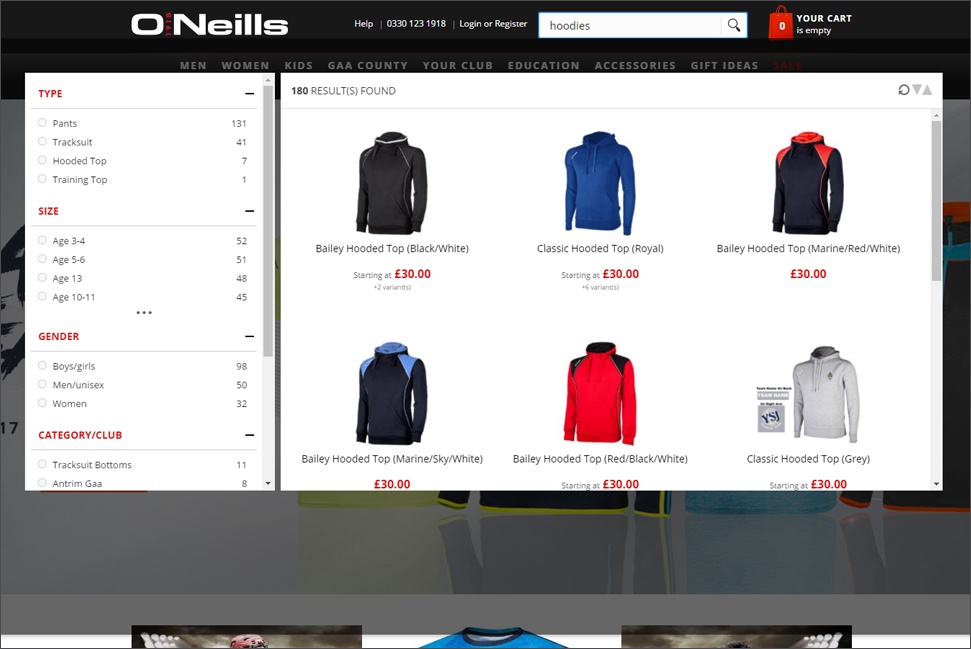Blog
Current Trends In Ecommerce Site Search
The ecommerce landscape is changing dramatically, with retailers making constant leaps forward, such as Amazon’s trials of drone deliveries, and the slightly less ‘Brave New World’ concept of same-day delivery. Whilst these are at the very edge of ecommerce development, there are many more, small but incrementally significant steps that retailers are taking to drive forward ecommerce in today’s competitive market. With customer experience sitting at the heart of much ecommerce strategy, it’s vital that it keep pace with surrounding technologies, especially site search. In this article, we review some key trends in ecommerce site search, and highlight why they are important for online retail.
Search as a primary navigation

By far the majority of online stores still use a traditional, horizontal ‘main menu’ as their primary navigation, relying on customers to accept a category-based browsing route to shopping. Online heavyweights like Amazon, John Lewis and eBay have, for a long time, used an alternative approach, putting search at the heart of site navigation. Ask most people how they shop on either of these sites, and they will say that they simply type what they’re looking for into the search bar.
With developments in on-site search making it much more robust, and much more accurate, there is a growing trend for other retailers to adopt a search-centric approach, especially where the store has an extensive catalog spanning many, many categories and SKUs. A great example of this is Klevu’s customer Yamaha MusicSoft (https://uk.yamahamusicsoft.com), which has removed the focus around their category navigation, in favour of a central search bar which invites the customer to shop via search. With Klevu’s smart search technology underpinning this approach, a search-centric store can improve customer experience and can help customers make their purchasing journeys more quickly and more effectively.
With ecommerce revenues generated via smartphones now overtaking revenues generated via desktop devices, making search integral to the ecommerce experience makes a lot of sense. Category-based navigation systems can appear quite slow and lumbering, when used on mobile devices, and customers want to access what they’re looking for in as few steps as possible. Mobile customers tend to head straight to the search bar, so making this as easy as possible is a logical step.
Personalisation of search results
The new wave of search tools have at their core the ability to record and analyse search data, in order to provide real insights into customer behaviour. By analysing search terms used, as well as behaviour patterns including previous purchases, additions to the shopping basket and pages visited, retailers can build up a detailed picture of each customer. Using this data in isolation, and is comparison with data for other customers, they can offer highly accurate personalised shopping recommendations to each individual customer, leading to dramatic improvements in conversion rates and customer engagement.
Klevu’s self-learning capabilities have been a big driver of new customers and it’s one of the key areas that help to set us apart from competitors. By personalising results based on user behaviour and purchasing trends, merchants see huge improvements around conversion rates and ‘time to purchase’.
Faceted search
The trend towards ever larger product catalogs is nothing new, particularly for enterprise-level merchants, but the means by which retailers help customers to narrow their choices is developing. Faceted search has been used in many online stores for quite some time, but it is finally growing up, to become as much a part of ecommerce search as the search bar itself. Traditionally, faceted search has offered customers the ability to refine by attributes such as colour, size and brand. This is being taken much further, with price bands, star ratings and other more detailed attributes appearing in the faceted search sidebar.
As an example, a search on oneills.com for jerseys shows faceted search options covering product type, size and gender, as well as other options.

Another element of faceted search that is helping to speed up purchasing is the pre-selection of faceted search options, which is something that Klevu is able to do out of the box.
Merchandising of results
Older ecommerce platforms have tended to offer little in the way of merchandising options when it comes to search results. Result sets have often been presented in a seemingly random order, with little attempt to encourage a purchasing decision.
Today’s smart search systems leave all that behind, and instead provide a richer, more immersive experience for the customer. Features such as rich search dropdowns enable the store to present the most likely results as quickly as possible, often whilst the customer is still typing in their query (like with the Oneills example). These search dropdowns typically include auto-suggested products, as well as category matches, best-sellers and sometimes even content matches, such as blog posts and user guides.
Rich content search pages are also developing fast, to deliver information-rich results that drive customer engagement. An excellent example of this is the white goods retailer, ao.com. A search for ‘chest freezers’ on the ao.com website presents a clever and innovative carousel of their best-selling chest freezers, with full product details and a ‘view product’ button prominently positioned for the item being displayed. It’s very much a ‘cut to the chase’ approach, filtering out the best products from a huge range, to allow the customer to make their decision as quickly as possible, and without having to load multiple pages. Prominent positioning of product reviews is also a great use of the page, with social proof becoming ever more important in driving retail sales.

Smart search and NLP
As search becomes more central to online shopping, it is becoming much, much smarter. Earlier, keyword-focused search tools are looking increasingly limited, as they give way to the latest NLP-driven technologies. NLP, or natural language processing, focuses on meaning and context, rather than simple keyword matching. As such, NLP search results are far more relevant and accurate, and have the ability to get better over time, using self-learning abilities.
Traditionally, search would fall down when it came to typos, synonyms, regional or country-specific language variants and other complex queries. Solutions like ours can handle these types of queries much more effectively. By analysing search data, these new systems can become smarter over time too, making them an investment that just keeps on giving.
It’s clear to see that ecommerce is still very much on a journey. Currently, online retail accounts for just 7% of all retail spending, so there is evidently huge scope for big gains in the future. It’s impossible to predict with any degree of certainty which direction ecommerce will go in, and what evolutionary steps it will take in the short-term. However, it’s fair to say that on-site search is likely to dominate ecommerce development, and at last, to take centre stage in every online store.


